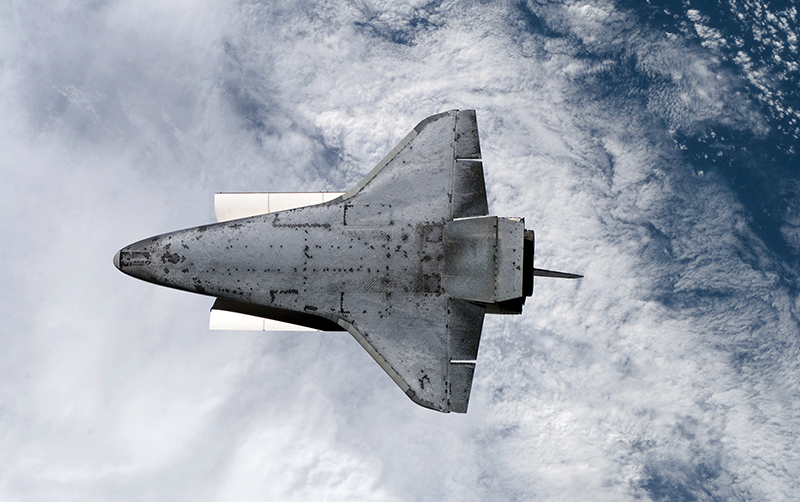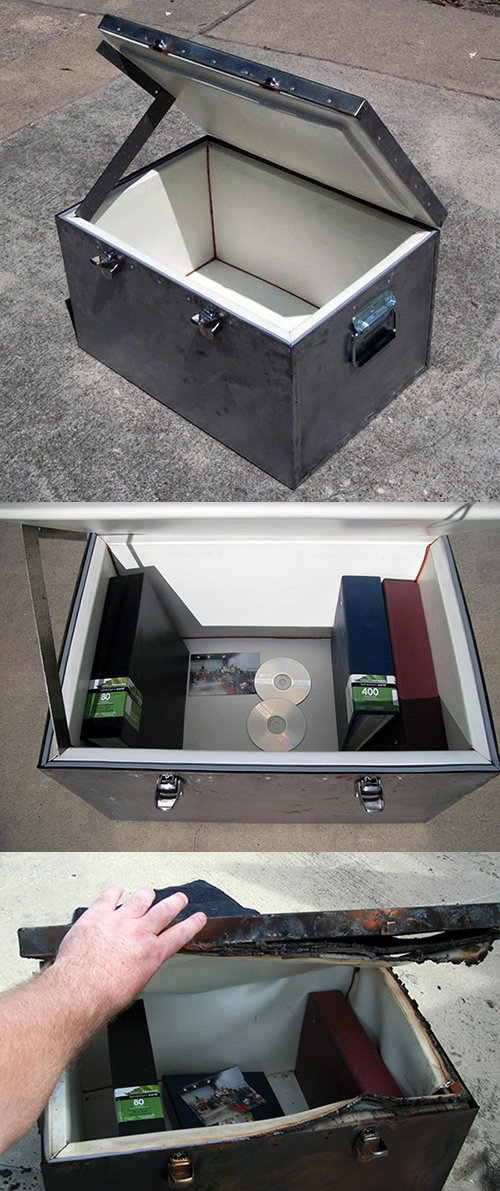
Thermal Materials Protect Priceless, Personal Keepsakes
NASA Technology
Most of us cannot comprehend the task of building something to withstand temperatures over 4,000 °F—but NASA can. The space shuttles endured such temperatures when returning to Earth’s atmosphere because of aerodynamic heating, or heating due to the combination of compression and surface friction from Earth’s atmosphere. For the vehicle to survive these fiery conditions, NASA scientists and engineers constructed a complex thermal protection system, or TPS, for the exterior of the shuttle.
The TPS consisted of various materials to radiate surface heat and inhibit any trace of heat from seeping inside the vehicle. The type of material used for the TPS depended on where it was placed. For example, reinforced carbon-carbon was used on the shuttle’s spots that got the hottest, such as on the wing leading edges and nose cap; felt reusable surface insulation protected the areas where temperatures would remain below 700 °F.
Over the decades, the TPS proved to be extremely successful and withstood the harshest tests of temperature. Following the Space Shuttle Columbia accident in 2003, however, NASA began developing materials and techniques for the inspection and repair of the TPS, should it be damaged during flight. Dr. Scott Parazynski, a five-time NASA astronaut, was designated the Astronaut Office lead for space shuttle TPS inspection and repair.
“We figured out different inspection procedures to make sure nothing happened to the TPS,” says Parazynski. “If it did, we had a series of repairs based on where the damage was located. We developed a suite of different tools and materials, and we developed confidence in them based on different test environments.”
For the remainder of the Space Shuttle Program, astronauts had various methods available for repair of the TPS while in orbit, if they were ever needed.
Technology Transfer
In 2009 Parazynski retired from NASA and met an entrepreneur with a hot idea for a NASA spinoff product incorporating concepts from the shuttle’s TPS inspection and repair. Christopher Shiver wanted to build an enclosure to protect priceless and irreplaceable personal items like keepsakes and photos in the event of a fire or flood. Years before, a flood inundated his own home, and while Shiver’s pictures and heirlooms remained safe, he wanted to ensure they would never be at risk again.
“When I dreamed of my new product, I knew there were people, materials, and designs at NASA that could help,” says Shiver.
After meeting Parazynski, Shiver shared his ideas about a fire-, heat-, and water-proof enclosure to protect priceless personal belongings. Parazynski then contacted other experts on heat transfer prevention materials, and by 2011 Shiver and Parazynski collaborated with Clark Thompson, an engineer who had worked with Parazynski at NASA. The three agreed to partner as co-owners of a company that Shiver founded just years before: Houston-based DreamSaver Enterprises LLC.
Parazynski says he and Clark borrowed some general concepts from their work in the space program and leveraged them for a commercial product. “We worked intently for 2-3 years after the Columbia accident to figure out ways to safely access and repair a damaged orbiter in space. The materials, general heat transfer background, and knowledge of different types of test environments fit nicely into the DreamSaver vision of using advanced materials for important purposes,” he says.
The trio approached the Houston Technology Center (HTC), an organization that supports emerging technology companies in the Houston area, and DreamSaver was soon accepted into the HTC/Johnson Space Center Incubator Partnership Program. This new program aims to increase collaboration between public and private entities and find areas of common interest to foster new technologies.
DreamSaver became the first company in the Incubator Program, and soon graduated to the HTC Acceleration Program and became a resident of the HTC/Johnson campus, part of the Johnson Acceleration Center. This is an additional HTC/Johnson collaboration to enhance partnerships and spur technology development by providing office space at Johnson.
According to Tim Budzik, managing director of the HTC/Johnson Partnership, “DreamSaver shows that NASA engineers are excellent problem solvers. After the Columbia accident, Scott [Parazynski] gained experience with the methodology that NASA uses to come up with solutions. He took that same technique and applied it to something right here at home.”
Benefits
DreamSaver’sProtection System, available for purchase online, is a footlocker-sized box with lightweight, low cost, industry leading thermal protection. It’s sealable and waterproof, made from the insulation technology developed by DreamSaver, and has been tested to 3,400 °F. According to the company, the product can withstand 98 percent of residential fires and 99 percent of water disasters.
As Shiver describes, the product is significantly different from a fireproof safe, which can get up to 300–400 °F inside, is made out of concrete and metal, and is relatively small. DreamSaver’s product is bigger, lighter, lower cost, and with higher thermal properties. “We stop the transfer of heat long enough for the fire to burn out or to be extinguished,” he says. “You can store 10 or 15 picture albums, scrapbooks, grandmother’s wedding dress, videos, or your children’s artwork inside of it.”
The company plans to make the product in the United States and can create custom coverings for the box to match the décor in a room or to fit individual preferences. Possible options include everything from cedar to floral prints to the colors of a favorite sports team. The company is also considering a cushion for the top of the box so it can function like a bench. “At its core, it is highly functional, but on the outside, we can customize it,” says Shiver.
TheProtection System is just the beginning for DreamSaver, says Shiver. Ultimately, the company plans to offer multiple sizes of the product with various functions and features, such as a GPS chip on the inside. “TheProtection System is just product number one,” he says. “We see custom solutions, applications, and markets in multiple industries related to heat and fire problems.”
Few of us can comprehend the pain of losing our priceless and irreplaceable personal keepsakes in a fire or flood. DreamSaver makes sure we will never have to—thanks to an innovative NASA-derived technology.
“Without a doubt, DreamSaver would not be in business if not for the HTC/Johnson Accelerator partnership,” says Shiver. “NASA is the key aspect of making it happen.

DreamSaver’s Home Protection System was constructed with knowledge from a NASA astronaut and engineer who helped to develop the repair techniques for the Space Shuttles’ TPS. In the images above, the box is shown before and after a 15-minute burn test at 3,400 °F.

Crewmembers on the International Space Station captured this image of the Space Shuttle Endeavour while checking the condition of the shuttle’s exterior thermal protection system (TPS).













